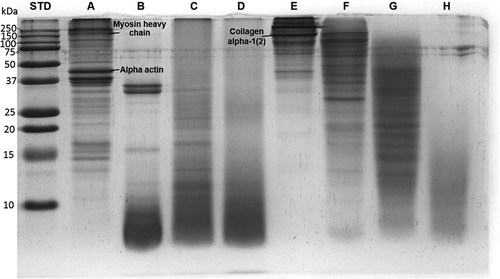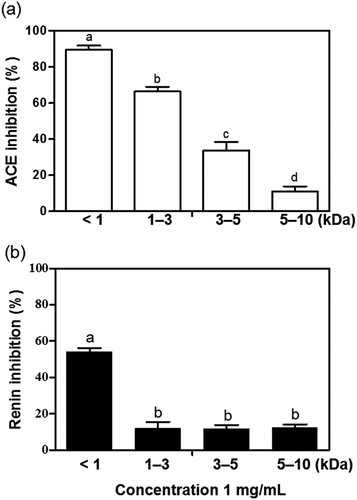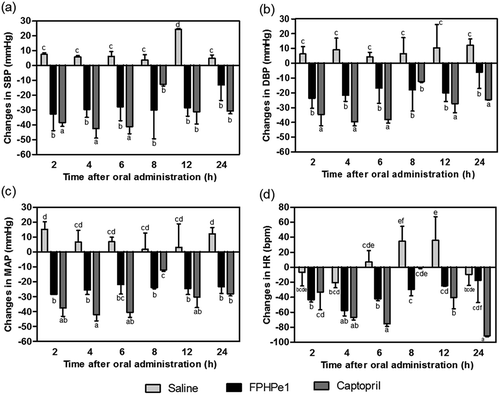Figures & data
Figure 1. (a) Degree of hydrolysis (DH) of tilapia frame protein isolate (FPI) during enzymatic hydrolysis. (b) DH of tilapia skin protein isolate (SPI) during enzymatic hydrolysis.

Table 1. Degree of hydrolysis (DH), protein content and yields of tilapia frame and skin protein hydrolysates after 4-h hydrolysis.
Figure 2. SDS-PAGE of samples from tilapia frame protein isolate (FPI, lane A), frame protein hydrolysates generated by pepsin (FPHPe, lane B), papain (FPHPa, lane C) and bromelain (FPHBr, lane D), skin protein isolate (SPI, lane E), and skin protein hydrolysates generated by pepsin (SPHPe, lane F), papain (SPHPa, lane G) and bromelain (SPHBr, lane H).

Table 2. Number of predictive angiotensin converting enzyme (ACE)-inhibitory peptides released from identified tilapia (a) frame proteins and (b) skin proteins using BIOPEP’s enzyme action tool.
Figure 3. (a) In vitro Angiotensin-I converting enzyme (ACE) inhibitory activities of frame protein hydrolysates (FPHs: FPHPe, FPHPa, and FPHBr) and skin protein hydrolysates (SPHs: SPHPe, SPHPa, and SPHBr) generated by pepsin, papain, or bromelain. Bars with different letters are significantly different (p < 0.05). (b) The correlation plot between degree of hydrolysis (DH) and ACE inhibitory activities for FPHs (●) and SPHs (▲). The Pearson’s r value is 0.9607 and p < 0.05 represents the correlation is significant.

Figure 4. (a) In vitro angiotensin-I converting enzyme (ACE) inhibitory activities of the ultrafiltration fractions of pepsin-hydrolyzed frame protein hydrolysate (FPHPe) at of 0.6 mg/mL. (b) In vitro renin inhibitory activities of the fractions from FPHPe at of 1 mg/mL. Bars with different letters have significantly (p < 0.05) different mean values.

Figure 5. The effect of the < 1 kDa ultrafiltration fraction from pepsin-hydrolyzed frame protein hydrolysate (FPHPe1) on (a) systolic blood pressure (SBP), (b) diastolic blood pressure (DBP), (c) mean arterial pressure (MAP), and (d) heart rate (HR) of spontaneously hypertensive rats (SHRs) after oral gavage. Different letters above the bars indicate significant differences (p < 0.05).

